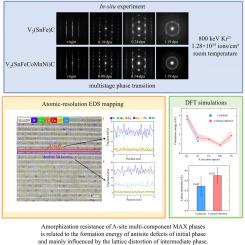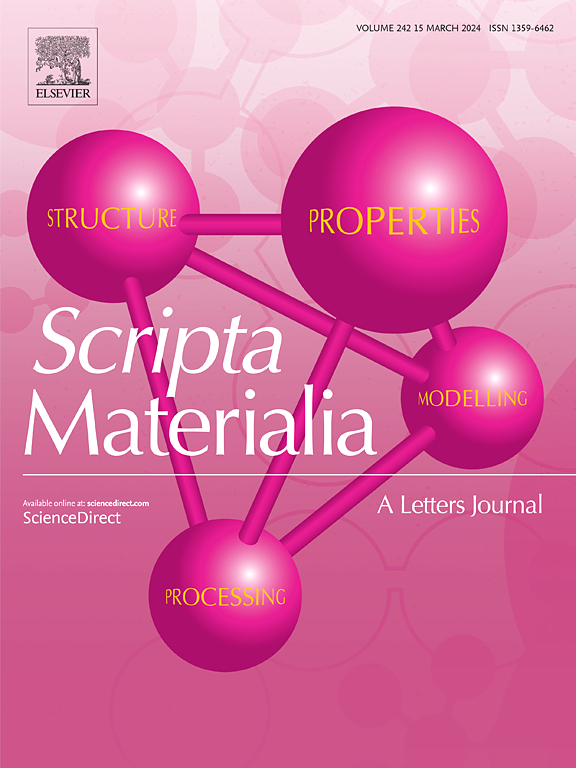原位离子辐照下a位多组分MAX相V2(SnFeCoMnNi)C和V2(SnFe)C的非晶化阻力
IF 5.6
2区 材料科学
Q2 MATERIALS SCIENCE, MULTIDISCIPLINARY
引用次数: 0
摘要
材料的化学成分在决定其在极端条件下(如辐照)的性能方面起着关键作用。在这项研究中,我们研究了具有不同a位元成分的多组分MAX相V2(SnFeCoMnNi)C和V2(SnFe)C的辐照诱导结构演化。通过原位辐照实验,我们发现两组分V2(SnFe)C和五组分V2(SnFeCoMnNi)C材料都经历了多阶段相变和非晶化。值得注意的是,与V2(SnFeCoMnNi)C相比,V2(SnFe)C具有更强的抗非晶化能力。第一性原理计算表明,V2(SnFe)C在辐照下性能的增强是由于其在初始相的反位缺陷形成能量较低,而在辐照过程中形成的中间γ相的晶格畸变减少。这些特性有助于调节辐照缺陷,使晶格在辐照下稳定。该研究为评价MAX相的辐射耐受性提供了一种潜在的方法,并对复杂陶瓷的组分调节具有启发作用。本文章由计算机程序翻译,如有差异,请以英文原文为准。

Amorphization resistance in A-site multi-component MAX phases V2(SnFeCoMnNi)C and V2(SnFe)C under in-situ ion irradiation
The chemical composition of materials plays a critical role in determining their performance under extreme conditions, such as irradiation. In this study, we investigate the irradiation-induced structural evolution in multi-component MAX phases V2(SnFeCoMnNi)C and V2(SnFe)C with varying A-site components. Through in-situ irradiation experiments, we demonstrate that both the two-component V2(SnFe)C and the five-component V2(SnFeCoMnNi)C material undergo multi-stage phase transformations and amorphization. Notably, V2(SnFe)C exhibits superior resistance to amorphization compared to V2(SnFeCoMnNi)C. First-principles calculations reveal that the enhanced performance of V2(SnFe)C under irradiation is attributed to its lower antisite defect formation energy in the initial phase and the reduced lattice distortion in the intermediate γ-phase formed during irradiation. These characteristics facilitate the accommodation of irradiation-induced defects and stabilize the lattice under irradiation. This study provides a potential way to evaluate the radiation tolerance of MAX phases and has an inspiring role in the component regulation in complex ceramics.
求助全文
通过发布文献求助,成功后即可免费获取论文全文。
去求助
来源期刊

Scripta Materialia
工程技术-材料科学:综合
CiteScore
11.40
自引率
5.00%
发文量
581
审稿时长
34 days
期刊介绍:
Scripta Materialia is a LETTERS journal of Acta Materialia, providing a forum for the rapid publication of short communications on the relationship between the structure and the properties of inorganic materials. The emphasis is on originality rather than incremental research. Short reports on the development of materials with novel or substantially improved properties are also welcomed. Emphasis is on either the functional or mechanical behavior of metals, ceramics and semiconductors at all length scales.
 求助内容:
求助内容: 应助结果提醒方式:
应助结果提醒方式:


